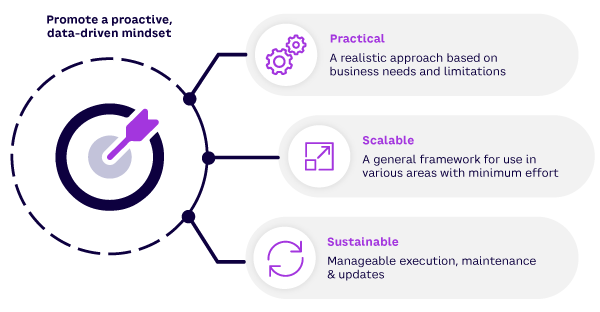In a previous Advisor, we outlined our rationale behind transitioning from reactive modes of data analytics (namely descriptive and diagnostic analytics) to a proactive approach through prescriptive analytics. This Advisor reflects on the vision and strategy that drove the journey.
Vision & Strategy
Our prescriptive analytics implementation was rooted in our vision to improve operational efficiency and product quality by shifting from reactive to proactive modes of operation. In short, we conceptualized a pragmatic digital capability that could be integrated with a new way of working to proactively identify and expediently resolve process-related challenges.
This vision translated into a primary objective: empowering stakeholders with rapid and live data analytics capabilities, enabling swift monitoring of the latest batches, and providing process-related suggestions to mitigate or avoid unfavorable process-performance situations. We aimed to detect anomalies and divergence in process performance while providing actionable recommendations to mitigate potential issues. To reach this objective, we formulated a strategy that prioritized practicality, scalability, and sustainability in product design and deployment (see Figure 1).

In designing the product, we took a practical, realistic approach that addressed the specific needs and limitations of our business environment. Numerous ideas were proposed, but we recognized the importance of simplicity and effectiveness in ensuring user adoption and decision-making support. We therefore focused on providing actionable information without requiring users to run models or manipulate data sets. This streamlined approach ensured that the tool remained user-friendly and streamlined decision-making.
Our strategy also placed a significant emphasis on scalability, striving to craft a general framework that could be adapted to various process areas with minimal effort. Embracing a product-agnostic approach facilitated rapid deployment, enabling seamless integration into new areas in a matter of days. By formulating a business knowledge and parameter-mapping database to collect product- and process-specific requirements for each area and generating generalized code for visualizations and insights, we laid the groundwork for a scalable solution capable of evolving alongside our expanding facilities and products.
To ensure sustainability, we paid close attention to managing the execution, maintenance, and updates of the product within existing resource constraints. Effectively balancing the workload of the new product with ongoing tasks, projects, and manufacturing support ensured its viability and efficacy. Our aim was not to add to the workload of our teams, but rather to streamline their processes and provide them with the tools necessary to make informed decisions.
[For more from the authors on this topic, see: “Vision into Action: A Reflection on Sanofi’s Prescriptive Analytics Journey.”]






